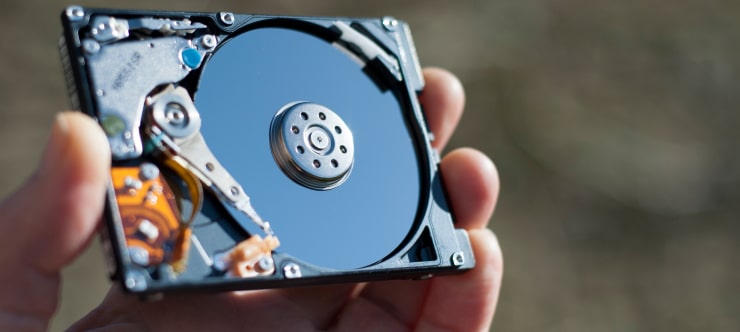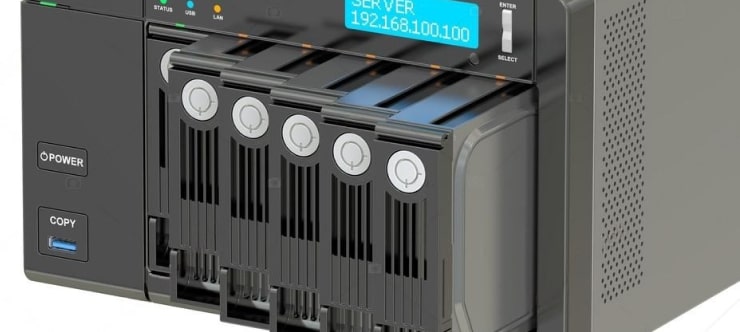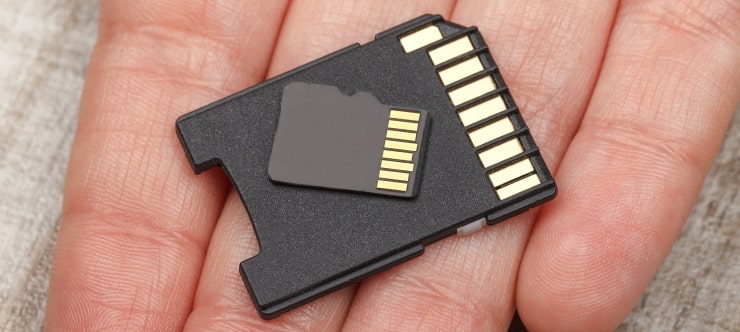Ransomware Attack Guide: How to Mitigate Damages

I think there's an issue with my storage device, but I'm not sure
Start a free evaluationRansomware mitigation refers to the strategies that organizations can use to reduce the impact of a ransomware attack that has already occurred. Ransomware attacks can be devastating, and organizations need to be prepared to respond quickly and effectively to minimize the damage.A good cybersecurity business continuity plan and an incident response plan are good ways to help you handle ransomware attacks. But ransomware mitigation has a lot of steps and demands speed in order to minimize the damage and prevent long downtime.
Ransomware mitigation strategies
Due to its severe consequences to businesses and organizations, ransomware mitigation must be along with other security measures. Here are actions you can take before an attack to minimize the potential of and damage caused by a cybersecurity breach.

These are the main ransomware mitigation strategies:
- Have a plan in place to respond to a ransomware attack, such as having backups of critical data. Backups should be stored offline and tested regularly to ensure they are working correctly.
- Create an Incident Response Plan to ensure business continuity in case of incidents like a cyber attack. Your cybersecurity team, IRR provider, or cyber insurance, can help you establish a comprehensive plan in case of a breach
- Keep software up to date to prevent vulnerabilities that ransomware can exploit. Organizations should apply security patches and updates as soon as they become available.
- Use multi-factor authentication to prevent unauthorized access to systems. Multi-factor authentication can help prevent attackers from gaining access to systems even if they have stolen login credentials.
- Train employees on how to recognize and avoid ransomware attacks. Employees should be aware of the risks of opening suspicious emails or clicking on links or attachments from unknown sources.
- Conduct regular security assessments to identify and address vulnerabilities. Security assessments can help organizations identify weaknesses in their security posture and take steps to address them.
- Consider cyber insurance to help cover the costs of a ransomware attack. Cyber insurance can help organizations recover from a ransomware attack by covering the costs of recovery and remediation.
- Work with Incident Response provider. Available at no cost, you can sign up with leading experts to help you from the first sign of an attack to complete recovery.
How to recover ransomware-encrypted data?
Important: If you have an incident response retainer (also known as IRR), or if you can employ an incident response service provider - contact them immediately. The chances of a full recovery grow exponentially, and most providers offer 24/7/365 support.
Ransomware attacks aren’t a simple case of data loss, as they impact a company’s time, money, and legal liability. This isn’t a DIY situation, but if you must try to mitigate damage yourself and if the data affected isn’t critical - there are a few solutions to restore files encrypted by ransomware. The best one is restoring the files from a backup, after removing the ransomware.Disconnect the infected device from the networkDisconnect the infected computer from the network and remove every storage device connected to it as soon as it is suspected of being infected.That is necessary to prevent ransomware from spreading across the network and encrypting critical and sensitive data.
Discover the ransomware type
Each of the ransomware types operates a little differently, so that will help you to find out what recovery options you have. Try ransomware ID tools to identify which strain of the malware has encrypted your files by uploading the ransom note, a sample encrypted file, and/or the attacker’s contact information. It will also direct you to a decryption implementation, should one be available.
Take a picture of the ransom note and encryption files
When attacked, you will be provided with a message that identifies the ransom, including the amount to be paid and where to send the payment.Take a picture of your screen as it will help data recovery specialists to determine which unlock methods should be applied. Also, you need it when reporting the attack to the authorities for further coordination measures to counter-attack
Backup recovery
Having a regular backup of your device data in external drives or cloud storage may save you a great amount of money in case of a ransomware attack.If you have a backup, reinstall everything from scratch, restoring the encrypted files from the original ones.Contact a ransomware removal service to ensure your device is secure and there are no more vulnerabilities on the system.
Ransomware FAQ
What is ransomware
Ransomware is an advanced malware (a common computer virus or network worm) that attacks both enterprises’ and individuals’ computers. It encrypts the data, making it impossible to access until the assigned ransom amount is paid to the hacker.Several hacker groups are performing the double extortion technique, in which not only the data is encrypted but also sensitive data is exfiltrated. The hacker then threatens to leak the data if the ransom is not paid during the given time.
How does it spread
Common ways ransomware is transmitted include:
Trojans
A trojan is a software that promises to perform one task but executes a different one, mostly malicious. They take the form of fake programs, attachments, and other types of files, deceiving victims.
Vulnerable remote service
One more way Rorschach ransomware attacks happen is through unsecured external remote services. Attackers will exploit Remote Desktop Protocol (RDP) tools whose credentials are known, reused, weak, or rephrased to gain access to businesses’ networks and leak data.
Known software vulnerabilities
Hackers use software with known vulnerabilities to attack businesses as well. That’s why it’s very important to also keep every software updated and protect remote administration tools like RDP. In the BabLock ransomware case, the group uses the legit security tool in Palo Alto Networks’ Cortex XDR as the initial attack method.
Spam email campaigns
This a phishing email attack where hackers use social engineering to deceive victims into clicking malicious links or attachments. After that, the exploit kit is downloaded into the machine and the threat actors can trigger ransomware at any moment. These emails can be targeted when hackers intend to access a specific business or can be non-targeted phishing when they send a mass malware spam campaign.

Unofficial software download sources and cracks
Pirate software and crack usually are malicious programs. Also, this software will not have the updates necessary to improve the program and prevent vulnerabilities that hackers can exploit.
Who is targeted by a ransomware attack?
As it was said before, literally anyone can be exposed to it. From private users to big enterprises and companies, and even government agencies, schools, and hospitals.All devices that can connect to a network or internet are susceptible to ransomware attacks: desktops, laptops, tablets, mobile devices, etc.
What types of ransomware there are?
Ransomware can be classified into 5 major categories:
Crypto Ransomware or Encryptors
This type of ransomware encrypts the victim's data and files, making them inaccessible until a ransom is paid.
Locker Ransomware
Locker ransomware completely locks the victim out of their system, making files and applications inaccessible.
Scareware
This is a type of ransomware that uses scare tactics to trick victims into paying a ransom. Scareware often displays fake warnings or alerts that claim the victim's system is infected with malware.
Doxware or Leakware
Doxware or leakware is a type of ransomware that threatens to publish the victim's sensitive data if a ransom is not paid.
Ransomware as a Service (RaaS)
RaaS refers to malware hosted anonymously by a "professional" hacker that handles all aspects of the attack, from distributing ransomware to collecting payments and restoring access, in return for a cut of the loot.
Summary
Do not pay the ransom! Transferring money to cyber criminals doesn’t guarantee your data back. However, you will be sponsoring their malicious practice and even terrorist activities.Backups stored in a safe place can help you minimize potential losses, reducing significantly the amount of corrupted data needed to be restored. However, if you haven’t got your system and data backed up providentially, you can count on the help of a data recovery company.
Related services
These are the most commonly requested data recovery services. At our headquarters' cleanroom lab, our certified engineers conduct a thorough review of any type of physical storage device, determining if there is logical or physical damage and carefully restoring all of the lost files.ces.

External Drive Data Recovery
We recover data from both external SSD and HDD drives. Rely on certified experts to restore your important files from damaged or corrupted external drives.

Hard Drive Data Recovery
Recover data from all brands of HDD, PC hard drives, and hybrid disks. Our specialists ensure fast and secure recovery for any data loss scenario.

NAS Data Recovery
Recover data from NAS devices, including RAID configurations. Our team handles all types of NAS systems and ensures data recovery with minimal downtime.

RAID Data Recovery
Our RAID data recovery services cover RAID 0, 1, 5, 10, and other configurations. We offer expert solutions for failed, degraded, or corrupted RAID arrays.

SAN Data Recovery
Our team specializes in handling SAN devices from leading manufacturers like Dell EMC, HP, and IBM, ensuring efficient recovery with minimal disruption to your operations.

SD Card Data Recovery
Our recovery experts specialize in restoring data from SD and memory cards. We guarantee quick recovery with a no-data, no-charge policy.

SSD Data Recovery
Our data recovery experts handle all SSD data loss scenarios with advanced tools, ensuring maximum recovery with high-security protocols.

USB Flash Drive Data Recovery
Recover lost data from USB flash drives, regardless of the damage or brand. We offer free in-lab evaluations to assess data recovery needs.
If you’re unsure about which data recovery service to choose, let our team assist you in selecting the appropriate solutions. We understand the anxiety that comes with a sudden drive failure, and we are more prompt in our actions compared to other recovery service providers.



